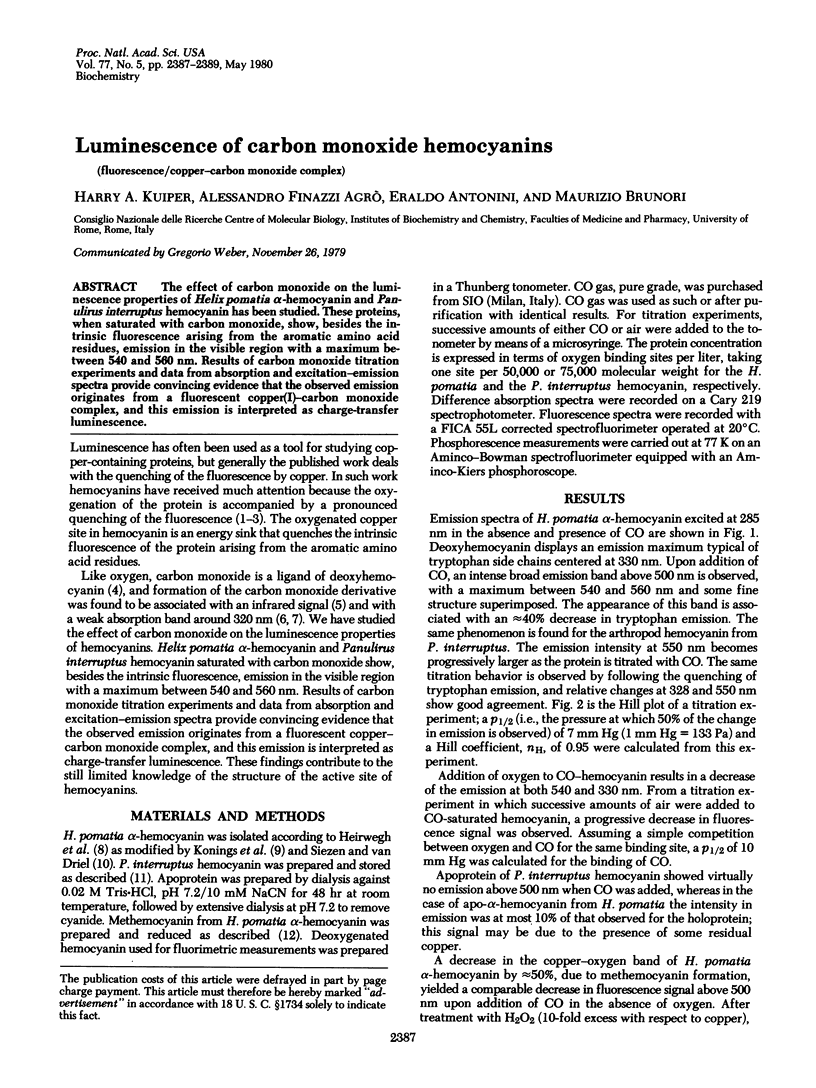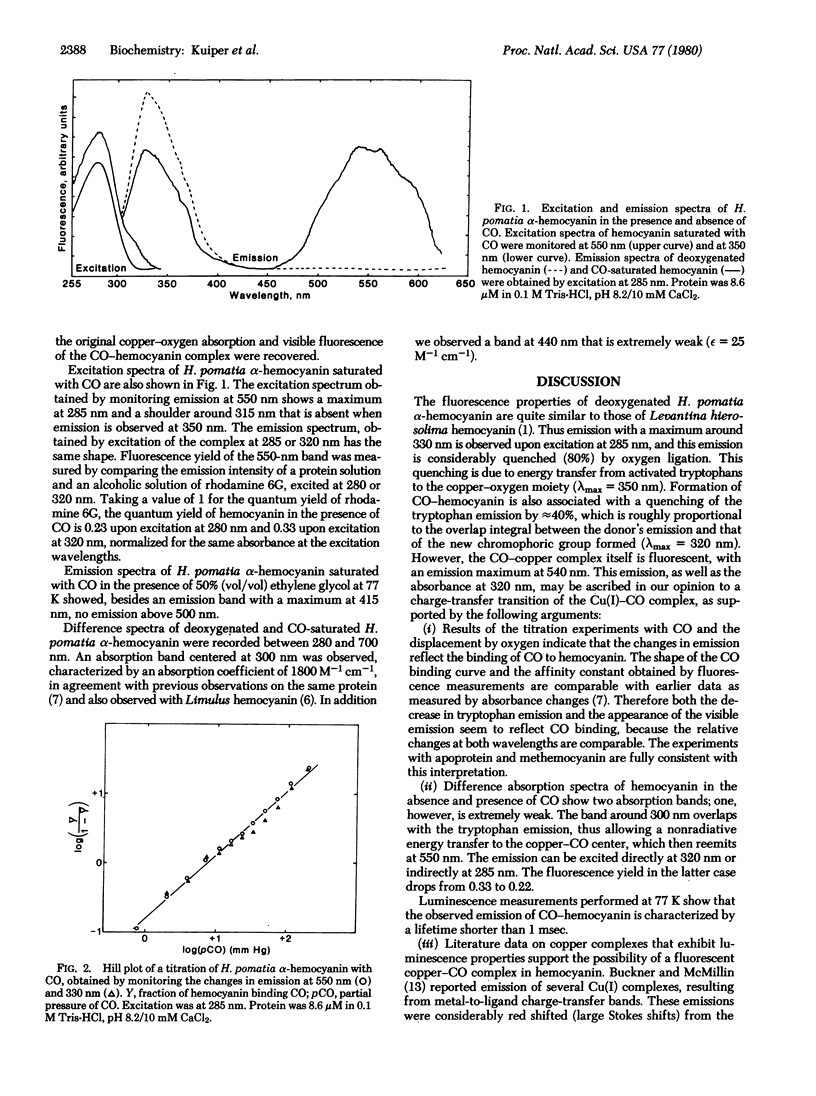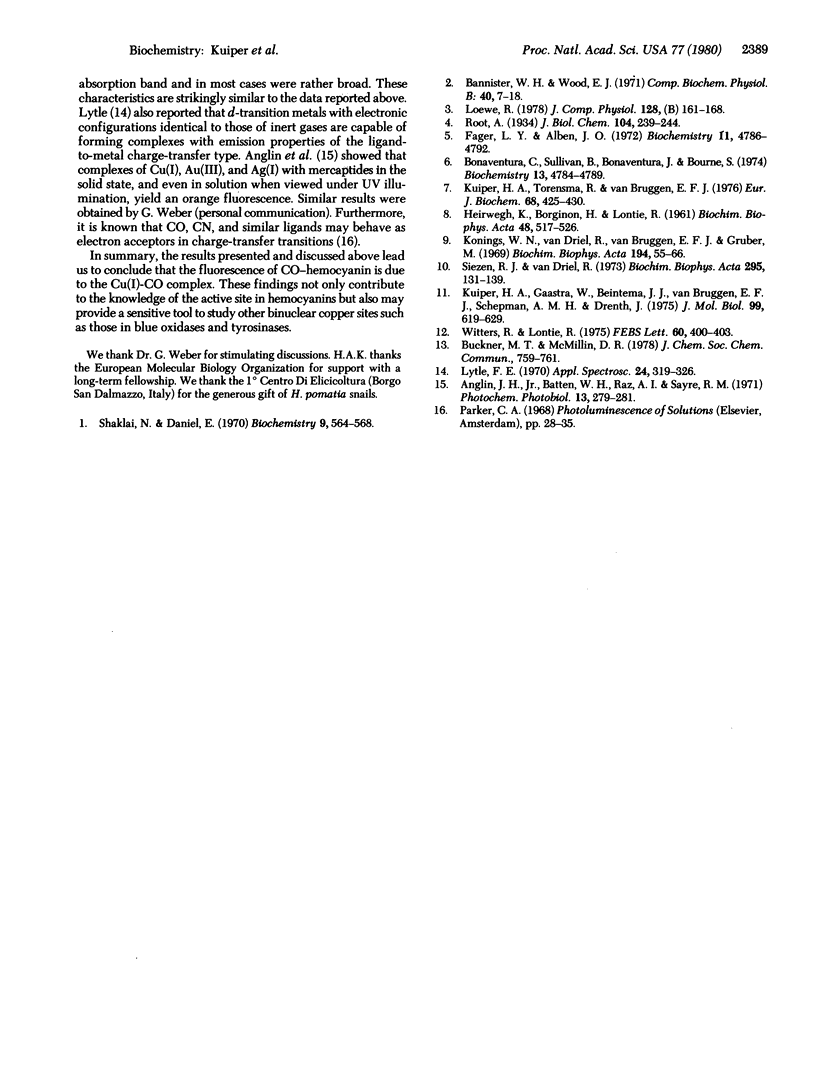Abstract
The effect of carbon monoxide on the luminescence properties of Helix pomatia alpha-hemocyanin and Panulirus interruptus hemocyanin has been studied. These proteins, when saturated with carbon monoxide, show, besides the intrinsic fluorescence arising from the aromatic amino acid residues, emission in the visible region with a maximum between 540 and 560 nm. Results of carbon monoxide titration experiments and data from absorption and excitation-emission spectra provide convincing evidence that the observed emission originates from a fluorescent copper(I)-carbon monoxide complex, and this emission is interpreted as charge-transfer luminescence.
Full text
PDF


Selected References
These references are in PubMed. This may not be the complete list of references from this article.
- Bonaventura C., Sullivan B., Bonaventura J., Bourne S. CO binding by hemocyanins of Limulus polyphemus, Busycon carica, and Callinectes sapidus. Biochemistry. 1974 Nov 5;13(23):4784–4789. doi: 10.1021/bi00720a016. [DOI] [PubMed] [Google Scholar]
- Fager L. Y., Alben J. O. Structure of the carbon monoxide binding site of hemocyanins studied by Fourier transform infrared spectroscopy. Biochemistry. 1972 Dec 5;11(25):4786–4792. doi: 10.1021/bi00775a023. [DOI] [PubMed] [Google Scholar]
- HEIRWEGH K., BORGINON H., LONTIE R. Separation and absorption spectra of alpha- and beta-haemocyanin of Helix pomatia. Biochim Biophys Acta. 1961 Apr 15;48:517–526. doi: 10.1016/0006-3002(61)90049-x. [DOI] [PubMed] [Google Scholar]
- Konings W. N., van Driel R., van Bruggen E. F., Gruber M. Structure and properties of hemocyanins. V. Binding of oxygen and copper in Helix pomatia hemocyanin. Biochim Biophys Acta. 1969 Nov 11;194(1):55–66. doi: 10.1016/0005-2795(69)90179-2. [DOI] [PubMed] [Google Scholar]
- Kuiper H. A., Gaastra W., Beintema J. J., van Bruggen E. F., Schepman A. M., Drenth J. Subunit composition, x-ray diffraction, amino acid analysis and oxygen binding behaviour of Panulirus interruptus hemocyanin. J Mol Biol. 1975 Dec 25;99(4):619–629. doi: 10.1016/s0022-2836(75)80176-8. [DOI] [PubMed] [Google Scholar]
- Kuiper H. A., Torensma R., Van Bruggen E. F. Binding of carbon monoxide to alpha-hemocyanin and beta-hemocyanin from Helix pomatia. Eur J Biochem. 1976 Sep 15;68(2):425–430. doi: 10.1111/j.1432-1033.1976.tb10829.x. [DOI] [PubMed] [Google Scholar]
- Shaklai N., Daniel E. Fluorescence properties of hemocyanin from Levantina hierosolima. Biochemistry. 1970 Feb 3;9(3):564–568. doi: 10.1021/bi00805a016. [DOI] [PubMed] [Google Scholar]
- Siezen R. J., van Driel R. Structure and properties of hemocyanins. 8. Microheterogeneity of -hemocyanin of Helix pomatia. Biochim Biophys Acta. 1973 Jan 25;295(1):131–139. doi: 10.1016/0005-2795(73)90080-9. [DOI] [PubMed] [Google Scholar]
- Witters R., Lontie R. The formation of Helix pomatia methaemocyanin accelerated by azide and fluoride. FEBS Lett. 1975 Dec 15;60(2):400–403. doi: 10.1016/0014-5793(75)80758-7. [DOI] [PubMed] [Google Scholar]


